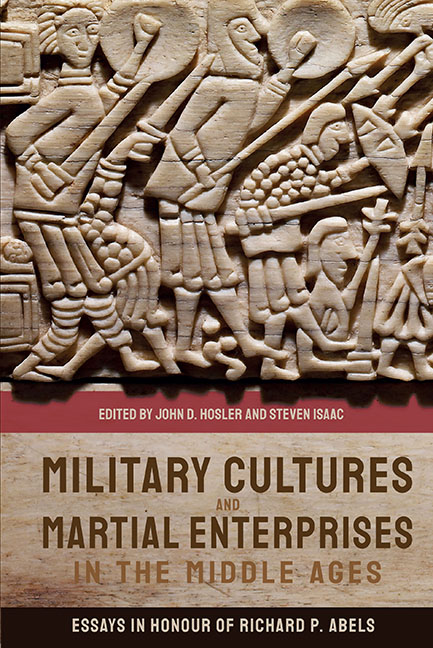Book contents
- Frontmatter
- Contents
- List of Illustrations
- Notes on Contributors
- Introduction and Appreciation
- 1 Charlemagne’s Invasion of Spain in 778: The Anatomy of a Strategic Failure and its Impact
- 2 Military Intelligence and Strategic Planning Under the Ottonian Kings of Germany, 919–1024
- 3 Ain’t Nobody Here But Us Chickens: Defeated Warriors, Masculinity, and Mistaken Identity in Western Europe, 679–1141
- 4 Count Baldwin V of Flanders: Broker of Eleventh-Century Power
- 5 Kings and Fortuna: The Meanings of Brémule
- 6 Fighting the Last War: Remembering the Norman Conquest during the Anarchy
- 7 Gilbert of Mons’ Chronicle of Hainaut as a Source for Military History in the Twelfth Century
- 8 At Home with Roger of Howden
- 9 Embedded Reporters? Ambroise, Richard de Templo, and Roger of Howden on the Third Crusade
- 10 The Treatment of Male and Female Prisoners of War during the Third Crusade
- 11 Exempla, Crusade, and Chivalry
- 12 Frontier Warfare in the St Omer Chronicle
- 13 Some Observations on the Training of Medieval Warhorses
- Richard P. Abels’ Curriculum Vitae
- Index
- Tabula Gratulatoria
8 - At Home with Roger of Howden
Published online by Cambridge University Press: 21 October 2020
- Frontmatter
- Contents
- List of Illustrations
- Notes on Contributors
- Introduction and Appreciation
- 1 Charlemagne’s Invasion of Spain in 778: The Anatomy of a Strategic Failure and its Impact
- 2 Military Intelligence and Strategic Planning Under the Ottonian Kings of Germany, 919–1024
- 3 Ain’t Nobody Here But Us Chickens: Defeated Warriors, Masculinity, and Mistaken Identity in Western Europe, 679–1141
- 4 Count Baldwin V of Flanders: Broker of Eleventh-Century Power
- 5 Kings and Fortuna: The Meanings of Brémule
- 6 Fighting the Last War: Remembering the Norman Conquest during the Anarchy
- 7 Gilbert of Mons’ Chronicle of Hainaut as a Source for Military History in the Twelfth Century
- 8 At Home with Roger of Howden
- 9 Embedded Reporters? Ambroise, Richard de Templo, and Roger of Howden on the Third Crusade
- 10 The Treatment of Male and Female Prisoners of War during the Third Crusade
- 11 Exempla, Crusade, and Chivalry
- 12 Frontier Warfare in the St Omer Chronicle
- 13 Some Observations on the Training of Medieval Warhorses
- Richard P. Abels’ Curriculum Vitae
- Index
- Tabula Gratulatoria
Summary
MASTER ROGER of Howden may not have written the most attractive, witty and engaging chronicles of his life and times, but their importance is beyond any dispute. For thirty years he was a member of the most powerful court of twelfth-century Western Europe and knew its personalities and its lord well. He was a witness, and in a small way a participant, in several ecclesiastical causes celèbres in both England and Scotland. He was also, as we now know, a frequent traveler to distant lands in his master's interests and an avid observer of the cultures he found far from his native Yorkshire. His chronicles, begun in 1169 as a travel diary and journal of his days as a young Angevin courtier in the final months of the Becket debacle, eventually mutated into a much more ambitious general chronicle of his age, which included England's back story to the time of Bede. It is, however, another aspect of his life that is the business of this chapter, one that has yet to be properly explored, but which nonetheless has something to say about the life and work of Roger of Howden. This is its local context: the minster church of Howden of which he was the head; the Yorkshire landed society of the East Riding and Lower Ouse basin in which he was brought up and lived, and the ecclesiastical community of the diocese of York of which he was part. This is one of those aspects of Roger's biography which has not to date been selected as being particularly germane to reconstructing his life, but as our colleague and friend Richard Abels has warned us, the evidence a biographer selects does tend to form the overall picture in unintended ways.
We know Roger better now than ever. The first editor of his works, William Stubbs, another clergyman whose roots were in Yorkshire, certainly established some matters, if he obscured others. He observed but discounted the similarities between Roger's Chronica and the earlier work known as the Gesta regis Henrici et Ricardi. But between the 1950s and 1980s a debate finally and firmly concluded that the works were both Roger’s.
- Type
- Chapter
- Information
- Military Cultures and Martial Enterprises in the Middle AgesEssays in Honour of Richard P. Abels, pp. 156 - 176Publisher: Boydell & BrewerPrint publication year: 2020

